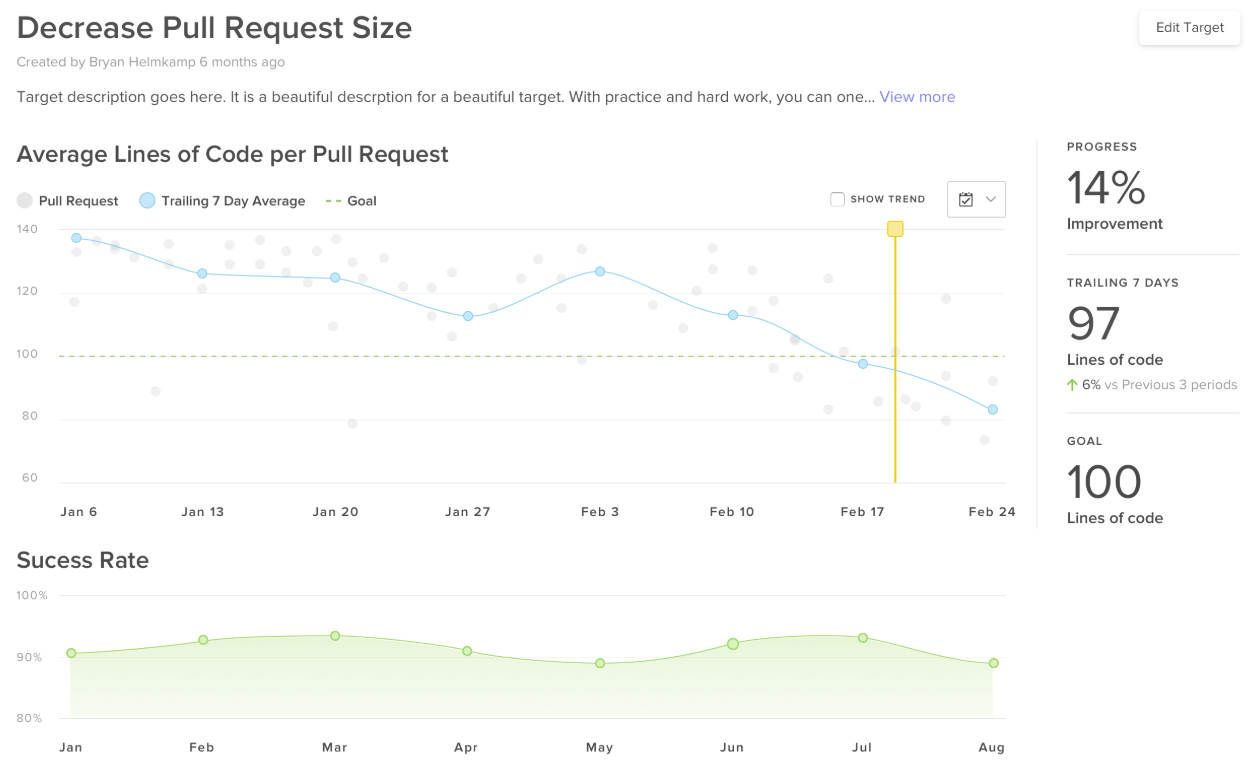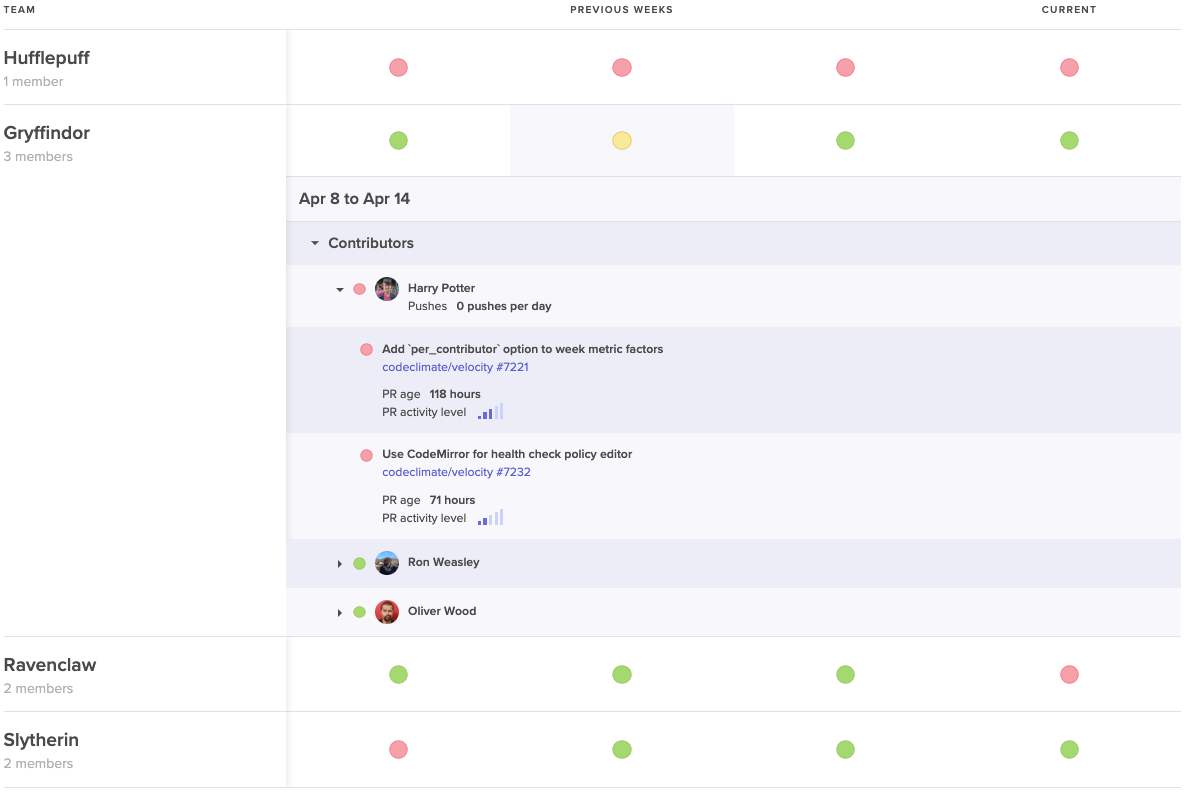“I tried everything in the industry: planning vs. execution, burndown charts, story points, time estimation. Finally, this product opened my mind. ” –Boaz Katz, CTO at Bizzabo
When we launched Velocity about a year ago, we were driven by our theory that the happiest engineers work on the most productive teams and vice versa. Our analytics tool gave managers an understanding of engineering speed and exactly when slowdowns occur.
After getting the product into the hands of thousands of early users, we were thrilled to discover that customers wanted ways to apply their new insights. They had the visibility to see when something went wrong, but not yet the diagnostic tools to determine the best remedy.
We also uncovered a wide range of priorities and needs across engineering teams. Data that was insightful to a large team was less valuable to a small team. Metrics that revealed coaching opportunities to managers of engineers were less useful to managers of managers. We knew early on that we had to build flexibility into the heart of Velocity.
One year and hundreds of meaningful conversations later, we’ve completely revamped the product.
Today, we’re proud to introduce Velocity 2.0, the most powerful Engineering Intelligence platform ever built. The all-new platform empowers any development team to eliminate bottlenecks and make lasting improvements to their team’s productivity.
Here’s how it works.
Actionability with deeper insights and concrete goals
Velocity 2.0 gives users the ability to drill down to the individual unit of work or habit that makes up a trend. This enables engineering teams to understand the underlying drivers of their productivity, so they can work together to improve the speed of innovation and the quality of software delivered.
With Velocity 2.0, engineering leaders can empower the entire engineering organization to participate in a culture of continuous improvement:
- Engineering Executives can gauge engineering speed over months or quarters but also slice and dice that same data however they’d like. They can see ROI across various initiatives such as restructuring teams or investing in new technologies.
- Engineering Managers have the visibility to see slowdowns and drill down into precisely why engineers are stuck. This helps them keep current sprints on track, and work with engineers to create optimizations that prevent future bottlenecks.
- Individual Developers will now have concrete success metrics to track their individual and team progress. This allows them to grow as engineers while supporting team and org objectives.
After engineering teams uncover opportunities for improvement, they can quickly translate them to action by setting measurable Targets within the application. They can then visualize and track progress to hit all their continuous improvement goals.

The industry’s first Targets feature lets you and each team member check in on your goal and how much progress you’ve made as a team.
Flexibility for teams to track what matters most
No two engineering teams are alike.
Some teams are heads-down, trying to ship as many features a possible before a target date, while others are trying to buckle down and prepare for scale. All-remote engineering teams require more communication and check-ins than teams in open offices. Velocity 2.0 is the only engineering analytics platform flexible enough to accommodate any software engineering team.
While Velocity 2.0 works right out of the box, it’s fully configurable. Users have the power to turn on and off whatever reports they care about and set their own definitions of success. Teams can customize:
- Metrics: Any metrics that aren’t currently a focus for your team, you can simply turn off. If your team prefers to not measure activity metrics, like commits or pushes, turn those off to focus more on metrics that represent value delivered, like pull requests merged or deploy volume.
- Algorithms: Build your own health checks based on the metrics you care about most. If “healthy” means a team that pushes small commits, gets through the review process quickly and deploys weekly, then Velocity 2.0 will adjust alerts based on those parameters.
- Thresholds: Mark anything you consider a red flag for the org, a team or an individual, and Velocity will highlight anything that might merit your attention, such as a large pull request, an overburdened developer, or a troublesome code review.
- Reports and Dashboards: Ask any questions that aren’t answered out of the box within the Reports Builder, then save within your own custom designed dashboards.
- Permissions: Some teams prefer to keep reports on a need-to-know basis only, based on role or user. This is particularly useful in cases where new team members are still working on their engineering chops. Set limited permissions so only you and the team member knows how a metric is trending.
Velocity 2.0 allows you to gauge success by your own organization’s definition, not our’s.

The new completely programmable Health Check report enables you to see at a glance how your team is doing this iteration compared to the previous three.
The future of engineering analytics
Velocity 2.0 is just the next step on our mission to create a more data-driven engineering world. With more visibility and the tools to take action, every software engineering team can boost their speed innovation, which, in turn, allows us as an industry, to overcome some of our biggest challenges, faster.
We’re incredibly grateful to our early users whose feedback was integral to the development of Velocity 2.0. Here’s what some of them had to say about it:
“Velocity’s Reports Builder has helped our team gain new insights into any potential bottlenecks in our sprints allowing us to definitively track our team progress, accelerate code reviews, pull data to match insights in retros and one-on-ones, and ultimately ship value to our customers significantly faster.” – Jacob Boudreau, CTO at Stord
“Thanks to Velocity, we’ve been able to actually get to a point where we’re doing atomic commits, everyone is committing more frequently, and reviews are easier.” – Chelsea Worrel, Software Engineer at Tangoe
“I’ve never seen anything quite like Velocity.” –Josh Castagno, Engineering Manager at Springbuk
Velocity 2.0 is most powerful when you can see it with your own data. Request a demo here.
Get articles like this in your inbox.
Trending from Code Climate
1.
Engineering Leaders Share Thoughts on Leadership in Disrupted Times in a New Survey
For engineering teams, disruption to the business can have a significant impact on the ability to deliver and meet goals. These disruptions are often a result of reprioritization and budget changes on an organizational level, and are amplified during times of transition or economic instability.

2.
Built In’s 2023 Best Places to Work — Why Code Climate Made the List
At Code Climate, we value collaboration and growth, and strive for greatness within our product and workplace. For us, this means fostering a supportive, challenging, people-first culture. Thanks to an emphasis on these values, we’ve earned spots on three of Built In’s 2023 Best Places to Work awards lists, including New York City Best Startups to Work For, New York City Best Places to Work, and U.S. Best Startups to Work For.

3.
Turnkey Deployment Delivers Day-One Value for Yottaa
Learn how Yottaa gained immediate value from Code Climate Velocity right out of the box.

Get articles like this in your inbox.
Get more articles just like these delivered straight to your inbox
Stay up to date on the latest insights for data-driven engineering leaders.

